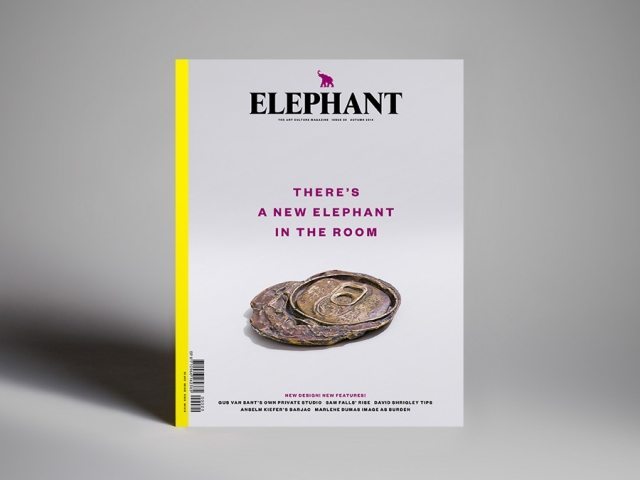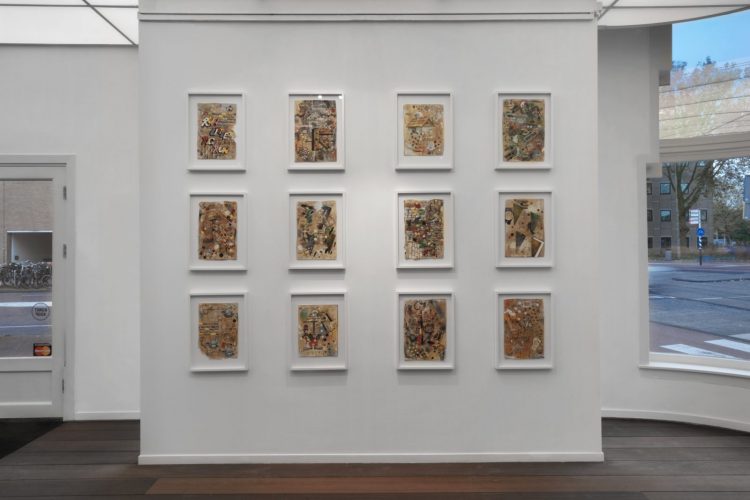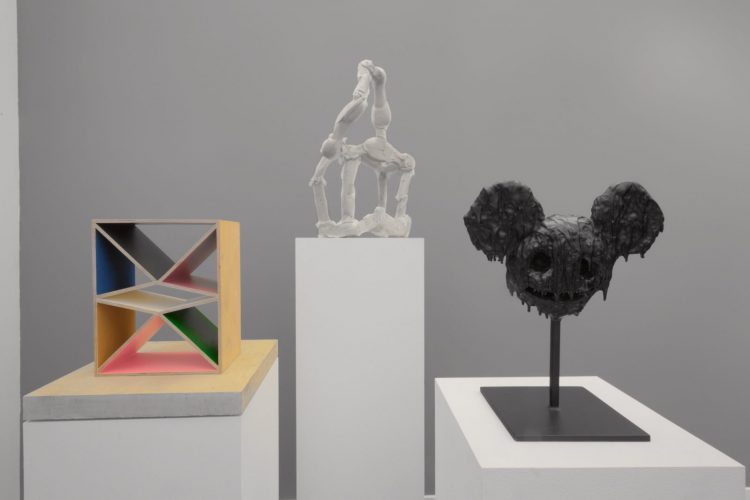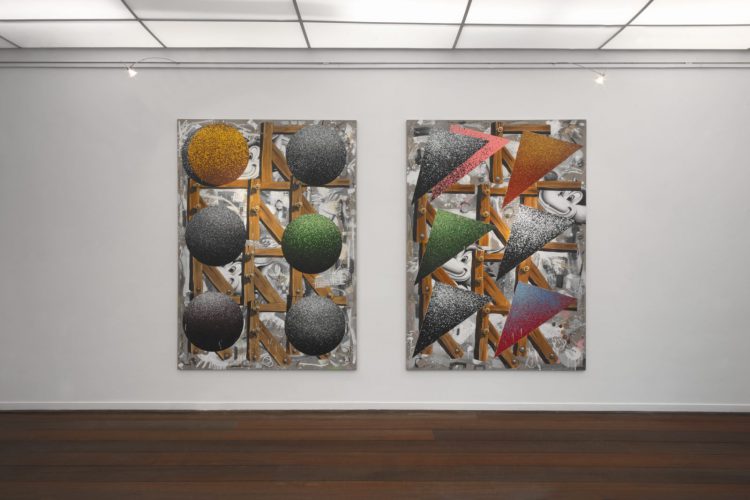Barry Reigate | Q&A by Elephant Magazine
Q&A with Barry Reigate

The London-based artist talks to us about his new show at Reflex Amsterdam
Barry Reigate's work is a powerful, eclectic and visually mind-blowing mix of symbolic pop imagery, geometrical design and multi-dimensional painterliness. Often on a large scale, with several components layered in spray paint, oil, pencil and other media, these arresting works both amuse and disturb; repel and seduce.
The introduction of a trapped, talismanic cartoon wolf character from the children's story The Three Little Pigs is a key motif in the fifteen exhibited works in his new show ?You Cannot Get Fingerprints From a Rock' at Reflex Amsterdam. We spoke to Barry about its meaning, and the way these works represent what he calls the ?hallucinogenics? of art.
Your current exhibition at Reflex Amsterdam is titled 'You Cannot Get Fingerprints From a Rock'. What do you mean by this?
The title in some ways could be about excess of information. It actually comes from a policeman, who, after an incident of someone throwing quite a large rock through our window, said to me the following words: ?You cannot get fingerprints from a rock?.
That statement, I suppose, just stayed within my subconscious and I always wanted to use it. Especially as it's about, in some ways, the stupidity of life? I basically waited two hours after reporting the incident, when all he could do was hold the rock and say those words - an obvious if somewhat useless statement. It was a bit like art? Somewhere I thought, through all this structured framework, system and authority, control and order, was something archaic or entopic. The policeman was like an outmoded policy. He wasn?t really of any help or service. It made me think? maybe crime does pay.
How does this exhibition fit in with your body of work so far?
The exhibition was really an extension of a previous show from some years back. This time I just added more obvious signifiers that engendered images from the storyThe Three Little Pigs, like airbrushed imagery of a wolf or pig taken from adverts or children's illustration. There is something I find significant about that story now, as it seems to fit into our western society of living, of economics, society, investing in structures, buildings, houses, the recent crash etc... Things seem so desperate now. Shouldn?t we really be thinking long term? Like investing in education rather than building straw houses that will blow away with the next political party.
I was interested to read that the exhibition catalogue describes your process as beginning 'with the minute details' and expanding 'to the grand narrative?. Do you work with a conception of what the finished narrative might be, or does this emerge in the process of making your works? In other words, do you have a plan?
I have an idea, but then that may become crushed through production, as I?m not really a conceptual artist. I make things, play around and generate narratives as I go along. It might be from an experience (for example the policeman) or from watching animation with my kids (like the wooden structure from a Smurf machine) or from the world around me like the unrest we had a few years back in 2011. These all flow into one and another and through anxiety, produce something from its excess - like a kind of expenditure of energy. I may go into the studio with an idea in mind but it could change because of something that caught my imagination from eating a falafel in the park. So, I suppose, in answer to your question: yes I do have a plan, a plan to be messed up, like a map to scribble and doodle over.
The concept of ?bad painting? suggests to me a visual counterpart of Michael Bakhtin's concept of the carnivalesque, where dominant styles are subverted (and in some ways liberated) by the presence of humour and chaos. The crazed cartoon figures in your paintings seem particularly to hit on this kind of idea. Do you think this is the case?
I have read Bakhtin while at college and I do like the idea of making work with the carnivalesque. I suppose the cartoon character does hit on that idea. What I want with them - in regards to how they are painted (airbrushed) - is to embrace a kind of underdog of representation. By that I mean, airbrushing the characters (like one would spray up a crash helmet or motorcycle tank) has a kind of grotesqueness to it; an exaggeration of form. The paintings become a mix of styles and forms fighting over each other, like one of the characters in François Rabelais? book Gargantua and Pantagruel.
You've described your work as the representation of a train of thought, like a child's bored doodle: puerile and chaotic. Some imagery is also drawn from juvenile life (I'm thinking of the wolves and pigs again, as well as the graphs and equations of school Maths tests). Do you find a certain humour in these artefacts of childhood?
For me, childhood has a great significance in my practice because of certain experiences I had as a child. Play was always a time to escape from the complexities and anxieties of that time and play involved humour, of course. I?ve always found that no matter what point you are at in your life - either high or low - humour is humbling, and a great incentive to keep moving; to carry on; to engender curiosity. I suppose when I make a work or think of ideas, I don?t really think of some grand narrative but the act of being, like doing a doodle or a drawing.
I see things around me that capture my imagination or give me an idea, like the Maths tests. I store it, source it, download it, trace it, scan it and then I press return and see where it goes from there. Life is like one big doodle: you know you are making a drawing or making a mark, but you don?t really know where its going to go, or how it is going to turn out. You think you are drawing a set of shelves but maybe you?re really thinking about social hierarchy or ancient physical structures. It's all there but at the same time it isn?t. In the end you?re left with a picture, a picture of ones life. It's up to you how much you participate or draw from that existence.
'You Cannot Get Fingerprints from a Rock' will show at Reflex Amsterdam until December 6.
The exhibition is accompanied by a book of the same name published by Reflex Editions.
www.reflexamsterdam.com
(source: frameweb.com)


